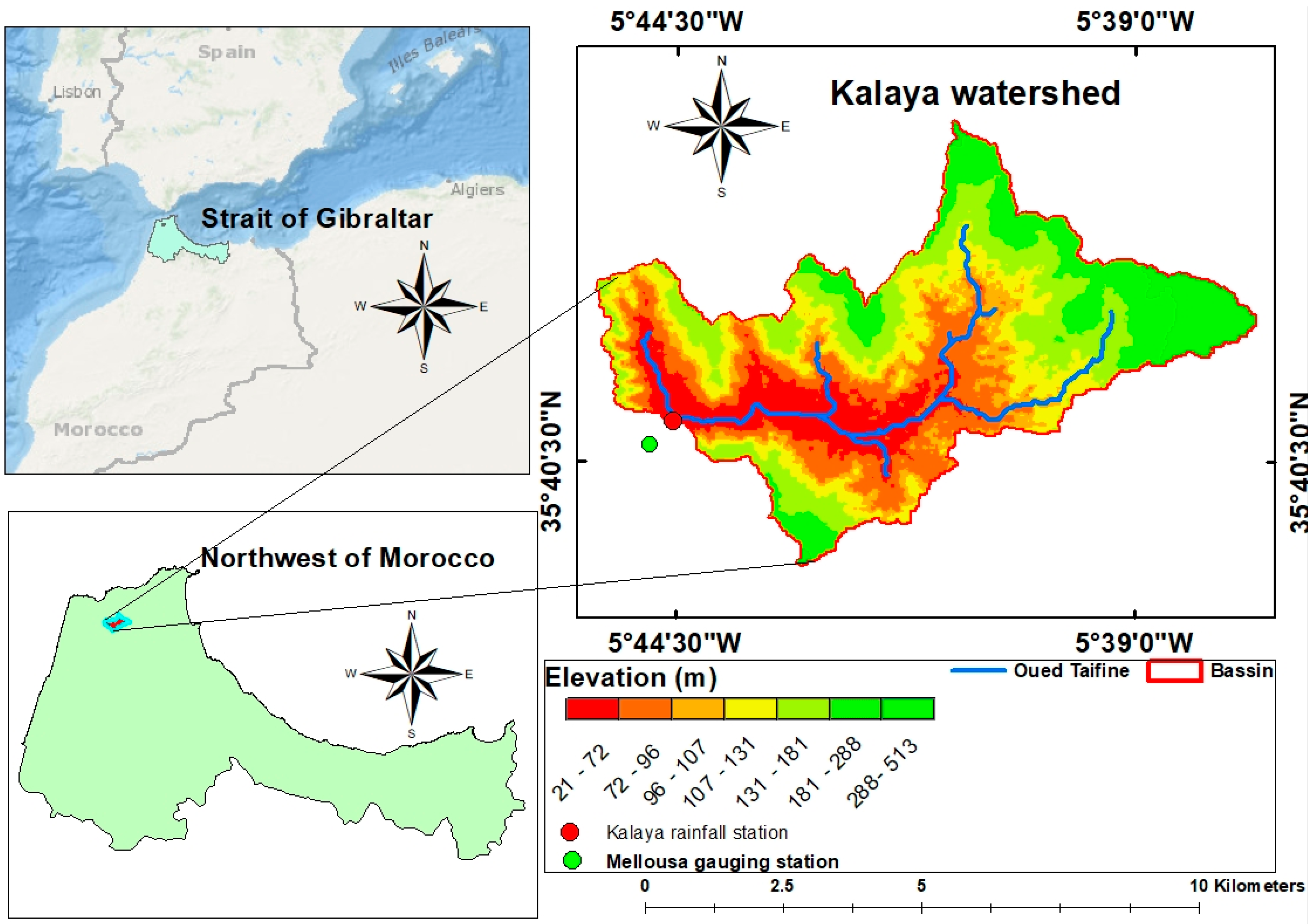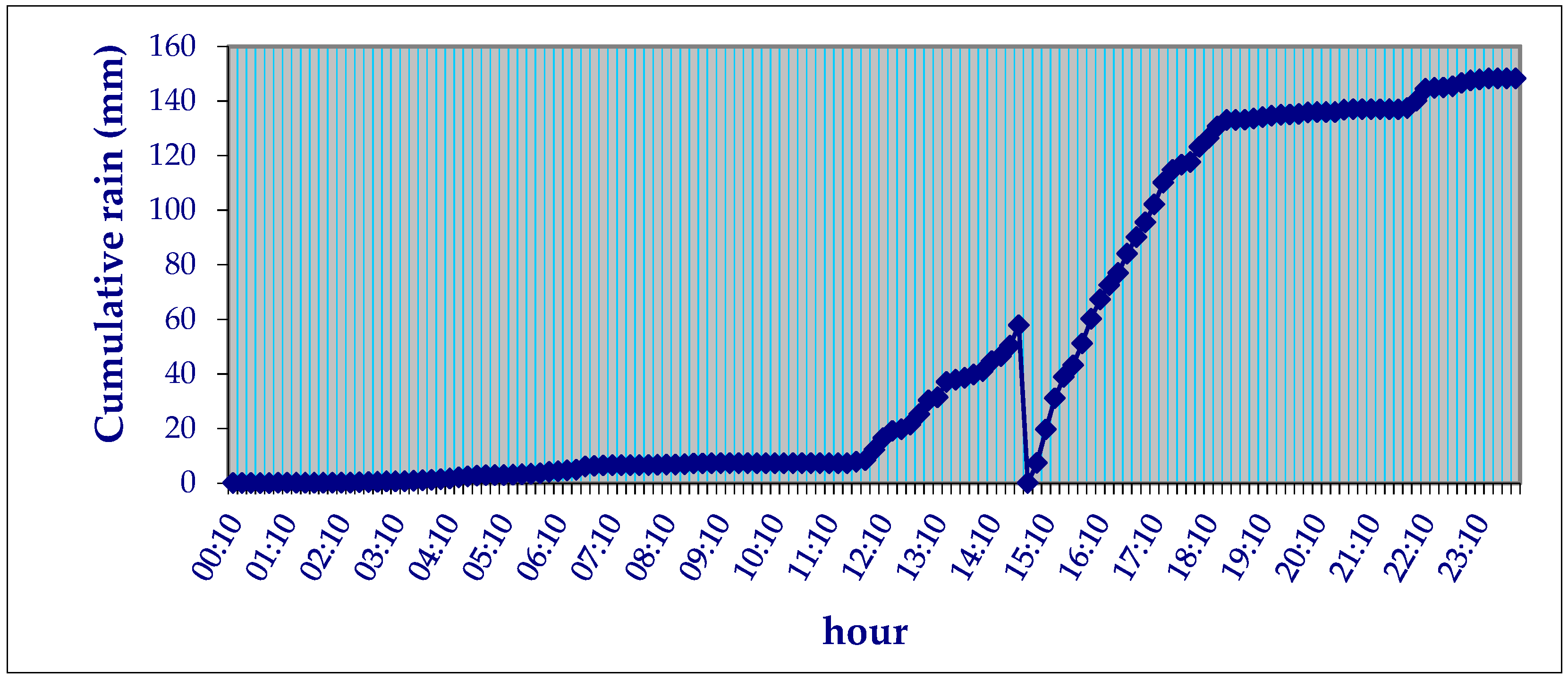Estimation of Peak Discharge in a Poorly Gauged Catchment Based on a Specified Hyetograph Model and Geomorphological Parameters: Case Study for the 23–24 October 2008 Flood, KALAYA Basin, Tangier, Morocco
Abstract
1. Introduction
2. Study Area
3. Materials and Methods
3.1. Analysis of Rainfall Data
3.2. Instantaneous Flows Determination
- (m3/s) = Rate of calculated flow width.
- (m) = Corresponding side reference to the flow rate qi.
- (m) = Gauge reference medium side (m).
- Q (m3/s) = Total rate of flow corresponding to the medium side H.
4. Results
4.1. HEC-HMS Modeling
4.2. Calibration Approch
5. Conclusions
Author Contributions
Funding
Conflicts of Interest
References
- Werren, G.; Lasri, M. Cartographie du Danger D’inondation. In Guide Pratique Pour L’application de la Méthode Suisse au Maroc; université de Lausanne and université Sidi Mohamed Ben Abdellah: Fès, Maroc, 2014. [Google Scholar]
- Norbiato, D.; Borga, M.; Sangati, M.; Zanon, F. Regional frequency analysis of extreme precipitation in the eastern Italian Alps and the August 29, 2003 flash flood. J. Hydrol. 2007, 345, 149–166. [Google Scholar] [CrossRef]
- Creutin, J.D.; Borga, M. Radar hydrology modifies the monitoring of flashflood hazard. Hydrol. Process. 2003, 17, 1453–1456. [Google Scholar] [CrossRef]
- Koutroulis, A.G.; Tsanis, I.K. A method for estimating flash flood peak discharge in a poorly gauged basin: Case study for the 13–14 January 1994 flood, Giofiros basin, Crete, Greece. J. Hydrol. 2010, 385, 150–164. [Google Scholar] [CrossRef]
- Lumbroso, D.; Gaume, E. Reducing the uncertainty in indirect estimates of extreme flash flood discharges. J. Hydrol. 2012, 414–415, 16–30. [Google Scholar] [CrossRef]
- Buchanan, T.J.; Somers, W.P. Discharge Measurements at Gaging Stations; Techniques of Water-Resources Investigation of the United States Geological Survey: Reston, VA, USA, 1969. [Google Scholar]
- Olson, S.A.; Norris, J.M. U.S. Geological Survey Streamgaging; U.S. Geological Survey Fact Sheet: Reston, VA, USA, 2005; pp. 2005–3131.
- Conesa-Garcia, C.; Caselles-Miralles, V.; Sanchez, J.M.; Garcia-Lorenzo, R. Hydraulic Geometry, GIS and Remote Sensing, Techniques against Rainfall-Runoff Models for Estimating Flood Magnitude in Ephemeral Fluvial Systems. Remote Sens. 2010, 2, 2607–2628. [Google Scholar] [CrossRef]
- Nouh, M. Effects of rainfall runoff model assumptions on optimal storm sewer system design. Arab. J. Sci. Eng. 1985, 12, 19–35. [Google Scholar]
- Huff, F. Time distribution of rainfall in heavy storms. Water Resour. Res. 1967, 3, 1007–1019. [Google Scholar] [CrossRef]
- Gaume, E.; Bain, V.; Bernardara, P.; Newinger, O.; Barbuc, M.; Bateman, A.; Blaškovicová, L.; Blöschl, G.; Borga, M.; Dumitrescu, A.; et al. A compilation of data on European flash floods. J. Hydrol. 2009, 367, 70–78. [Google Scholar] [CrossRef]
- Graef, F.; Haigis, J. Spatial and temporal rainfall variability in the Sahel and its effects on farmers’ management strategies. J. Arid Environ. 2001, 48, 221–231. [Google Scholar] [CrossRef]
- Ghimire, B.; Reddy, M.J. Development of stage-discharge rating curve in river using genetic algorithms and model tree. In Proceedings of the International Workshopadvances in Statistical Hydrology, Taormina, Italy, 23–25 May 2010. [Google Scholar]
- Pan, F.; Wang, C.; Xi, X. Constructing river stage-discharge rating curves using remotely sensed river cross-sectional inundation areas and river bathymetry. J. Hydrol. 2016, 540, 670–687. [Google Scholar] [CrossRef]
- Herschy, R.W. Streamflow Measurement; Elsevier Applied Science Publishers: New York, NY, USA, 1985. [Google Scholar]
- Dottori, F.; Martina, M.L.V.; Todini, E. A dynamic rating curve approach to indirect discharge measurement. Hydrol. Earth Syst. Sci. 2009, 13, 847–863. [Google Scholar] [CrossRef]
- Jothityangkoon, C.; Hirunteeyakul, C.; Boonrawd, K.; Sivapalan, M. Assessing the impact of climate and land use changes on extreme floods in a large tropical catchment. J. Hydrol. 2013, 490, 88–105. [Google Scholar] [CrossRef]
- Goodrich, D.; Woolhiser, D.; Unkrich, C. Rainfall-sampling impacts on runoff. In Hydraulics/Hydrology of Arid Lands; French, R.H., Ed.; American Society of Civil Engineers: New York, NY, USA, 1990; pp. 519–524. [Google Scholar]
- Mosley, M.P.; McKerchar, A.I. Streamflow, Handbook of Hydrology; Maidment, D.R., Ed.; McGraw-Hill: New York, NY, USA, 1992. [Google Scholar]
- Leopold, L.B.; Wolman, M.G.; Miller, J.P. Fluvial Processes in Geomorphology; W.H. Freeman: San Francisco, CA, USA, 1964. [Google Scholar]
- USDA. Summary Report: National Resources Inventory (Revised December 2001); US Department of Agriculture, Natural Resource Conservation Service: Washington, DC, USA, 1997.
- Ramirez, J.A. Prediction and Modeling of Flood Hydrology and Hydraulics. In Chapter 11 of Inland Floods Hazards: Human, Riparian and Aquatics Communities; Wohl, E., Ed.; Cambridge University Press: Cambridge, UK, 2000. [Google Scholar]
- Khaddor, I.; Alaoui, A.H. Production of a Curve Number map for Hydrological simulation—Case study: Kalaya Watershed located in Northern Morocco. Int. J. Innov. Appl. Stud. 2014, 9, 1691–1699. [Google Scholar]
- Cunderlik, J.M.; AndSimonovic, S.P. Inverse flood risk modeling under changing climatic conditions. Hydrol. Process. 2007, 21, 563–577. [Google Scholar] [CrossRef]
- McColl, C.; Aggett, G. Land-use forecasting and hydrologic model integration for improved land-use decision support. J. Environ. Manag. 2007, 84, 494–512. [Google Scholar] [CrossRef] [PubMed]
- Guo, J.C.Y.; Hargadin, K. Conservative Design Rainfall Distribution. J. Hydrol. Eng. 2009, 14. [Google Scholar] [CrossRef]
- Al-Rawas, G.A.; Valeo, C. Characteristics of rainstorm temporal distributions in arid mountainous and coastal regions. J. Hydrol. 2009, 376, 318–326. [Google Scholar] [CrossRef]
- Casas, A.; Benito, G.; Thorndycraft, V.R.; Rico, M. The topographic data source of digital terrain models as a key element in the accuracy of hydraulic flood modelling. Earth Surf. Process. Landf. 2006, 31, 444–456. [Google Scholar] [CrossRef]
- Vidal, J.-P.; Moisan, S.; Faure, J.-B.; Dartus, D. River model calibration, from guidelines to operational support tools. Environ. Model. Softw. 2007, 22, 1628–1640. [Google Scholar] [CrossRef]
- Morvan, H.; Knight, D.; Wright, N.; Tang, X.; Crossley, A. The concept of roughness in fluvial hydraulics and its formulation in 1D, 2D and 3D numerical simulation models. J. Hydraul. Res. 2008, 46, 191–208. [Google Scholar] [CrossRef]
- Paarlberg, A.J.; Dohmen-Janssen, C.M.; Hulscher, S.J.M.H.; Termes, P.; Schielen, R. Modelling the effect of time-dependent river dune evolution on bed roughness and stage. Earth Surf. Process. Landf. 2010, 35, 1854–1866. [Google Scholar] [CrossRef]
- World Meteorological Organization. Manual on Stream Gauging, Volume II—Computation of Discharge; WMO-No. 1044; World Meteorological Organization: Geneva, Switzerland, 2010; ISBN 978-92-63-11044-2. [Google Scholar]
- Van der Klis, H. Uncertainty Analysis Applied to Numerical Models of River Bed Morphology. Ph.D. Thesis, University of Delft, Delft, The Netherlands, 2003. [Google Scholar]
- Paarlberg, A.J. Modelnauwkeurigheid en-Onzekerheden van in Nederland Toegepaste Hydraulische Modellen: Verslag van Interviews met Waterbeheerders en Modelexperts (in Dutch); Civil Engineering and Management Research Report 2007R-001/WEM-001; University of Twente: Enschede, The Netherlands, 2007. [Google Scholar]
- Warmink, J.J.; Booij, M.J.; van der Klis, H.; Hulscher, S.J.M.H. Uncertainty in water level predictions due to various calibrations. In Proceedings of the CAIWA 2007, Basel, Switzerland, 12–15 November 2007; pp. 1–18. [Google Scholar]
- United States Army Corp of Engineering (USACE). Hydrologic Modeling System HEC-HMS; USACE: Washington, DC, USA, 2000. [Google Scholar]
- Scharffenber, W.A.; Fleming, M.J. Hydrological Modeling System HEC-HMS User’s Manual; United States Army Corps of Engineers: Davis, CA, USA, 2010.






| 9 Section | Period | Velocity (m/s) | Perimeter (m) | Roughness | Water Levels (m) | Discharge (m3/s) |
|---|---|---|---|---|---|---|
| 1 | 12/11/2012 | 0.316 | 0.12 | 0.004 | 1.00 | 0.023 |
| 2 | 11/03/2008 | 0.303 | 0.08 | 0.004 | 1.10 | 0.040 |
| 3 | 18/02/2008 | 0.342 | 0.11 | 0.004 | 1.20 | 0.250 |
| 4 | 22/01/2008 | 0.381 | 0.08 | 0.004 | 1.33 | 0.750 |
| 5 | 24/12/2007 | 0.29 | 0.08 | 0.004 | 1.50 | 2.000 |
| 6 | 11/06/2013 | 0.168 | 0.07 | 0.004 | 1.80 | 5.900 |
| 7 | 13/05/2013 | 0.148 | 0.07 | 0.004 | 2.00 | 9.700 |
| 8 | 11/02/2013 | 0.353 | 0.12 | 0.004 | 2.20 | 14.500 |
| 9 | 21/04/2008 | 0.45 | 0.24 | 0.004 | 2.50 | 23.500 |
| 10 | 09/12/2003 | 1.813 | 1.18 | 0.004 | 2.66 | 28.971 |
| S. deviation | 0.62 | 10.55 |
| Physical Components | Loss Method | Transform Method | |||
|---|---|---|---|---|---|
| Surface (Km2) | Slope (%) | Perimeter (Km) | Initial Abstraction (mm) | Average CN | Lag Time (hours) |
| 37.3 | 8.47 | 13.205 | 8 | 82.07 | 2.082715 |
| Bassin | Drainage Area Km2 | Peak Discharge m3/s | Peak Time | Volume (1000 m3) |
|---|---|---|---|---|
| KALAYA | 37 | 321.9 | 23 October 2008, 18:18 | 5553.8 |
| Parameter | Initial Value | Optimized Value | Objective Function Sensitivity |
|---|---|---|---|
| Curve Number | 82 | 89.162 | 7.68 |
| Initial Abstraction (mm) | 8 | 7.3789 | −43.47 |
| SCS Lag (min) | 124.9629 | 36.286 | −30.05 |
| Measure | Simulated | Observed | Difference | Percent Difference |
|---|---|---|---|---|
| Volume | 5593.4 | 5193.3 | 400.1 | 7.42 |
| Peak Flow | 321.9 | 486.7 | 164 | 40.52 |
| Time of Peak | 23 October 2008, 16:07 | 23 October 2008, 17:00 | ||
| Time of Center of Mass | 23 October 2008, 17:03 | 23 October 2008, 17:03 |
© 2019 by the authors. Licensee MDPI, Basel, Switzerland. This article is an open access article distributed under the terms and conditions of the Creative Commons Attribution (CC BY) license (http://creativecommons.org/licenses/by/4.0/).
Share and Cite
Khaddor, I.; Achab, M.; Ben jbara, A.; Hafidi Alaoui, A. Estimation of Peak Discharge in a Poorly Gauged Catchment Based on a Specified Hyetograph Model and Geomorphological Parameters: Case Study for the 23–24 October 2008 Flood, KALAYA Basin, Tangier, Morocco. Hydrology 2019, 6, 10. https://doi.org/10.3390/hydrology6010010
Khaddor I, Achab M, Ben jbara A, Hafidi Alaoui A. Estimation of Peak Discharge in a Poorly Gauged Catchment Based on a Specified Hyetograph Model and Geomorphological Parameters: Case Study for the 23–24 October 2008 Flood, KALAYA Basin, Tangier, Morocco. Hydrology. 2019; 6(1):10. https://doi.org/10.3390/hydrology6010010
Chicago/Turabian StyleKhaddor, Iliasse, Mohammed Achab, Abdelkader Ben jbara, and Adil Hafidi Alaoui. 2019. "Estimation of Peak Discharge in a Poorly Gauged Catchment Based on a Specified Hyetograph Model and Geomorphological Parameters: Case Study for the 23–24 October 2008 Flood, KALAYA Basin, Tangier, Morocco" Hydrology 6, no. 1: 10. https://doi.org/10.3390/hydrology6010010
APA StyleKhaddor, I., Achab, M., Ben jbara, A., & Hafidi Alaoui, A. (2019). Estimation of Peak Discharge in a Poorly Gauged Catchment Based on a Specified Hyetograph Model and Geomorphological Parameters: Case Study for the 23–24 October 2008 Flood, KALAYA Basin, Tangier, Morocco. Hydrology, 6(1), 10. https://doi.org/10.3390/hydrology6010010




